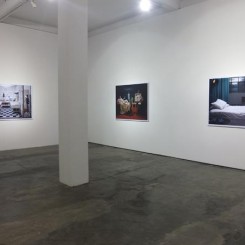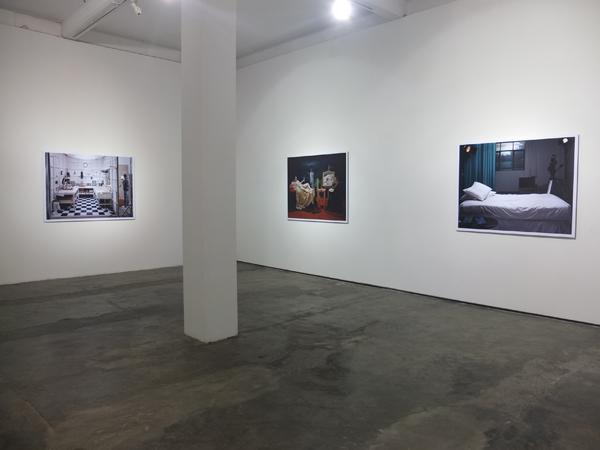“Image Uterus Production Power,” solo exhibition by Cai Dongdong
Gallery 55 (Bldg. 4A-112, 50 Moganshan Road, Shanghai, China), June 1–16, 2013
The Cai Dongdong exhibition at Gallery 55 has a very simple presentation and a very complex name. Simple, because there are only two parts to the exhibition: one being a circle of chairs arranged in a gallery space devoid of other objects, and the other being four photographs hung on blank walls in a separate space. The first exhibit is entitled “Appreciating Audiences,” wherein audience members can choose a seat from the circle of chairs, and sit, “appreciating” each other. The complexity of the piece emerges when viewers begin to consider who the true audience is and what is actually being observed. In the second exhibit, four photographs represent the theme of the exhibit — “Image Uterus Production Power.” At this point, every audience member has the right to ask of the artist: “Mister Cai, what are you doing?”
The four photographs are important conceptual works that Cai has done in recent years. Although they appear totally disparate in technique and appearance, the four pieces represent the artist’s reflection on the dual concepts of observation and presentation through photography. When Cai points his camera at the theme, and captures what Henri Cartier-Bresson called “the Decisive Moment,” more often than not, he has actually turned the lens upon himself. The reflected image begs the question of what Cai Dongdong is doing as an artist, and answering this question should be his most important task.
The carefully arranged scene in the artist’s 2009 work “Nine Squared Pattern Drawing” confronts the audience with a choice to make through its richly textured colors and detailed depiction of female sexual organs. The story illustrated here is either a scene from art history or a tale belonging between the sheets and behind closed doors.

Cai Dongdong, “Nine Squared Pattern Drawing,” C-Print, 117 x 157 cm, 2009
蔡东东,《九宫格绘图》,彩色打印,117 x 157 cm, 2009
In contrast, his 2010 piece “Bed” appears all the more pristine. The photographic equipment placed around this provocative piece of furniture and the glimpse of the scenery outside the room reveal the signs of carelessness and haste in this purposefully arranged scene. Whose bed is it? Who has wrinkled the sheets? What has been left behind? What is missing? In this piece, Cai once again utilizes the bed with all its significance in art history, and manually recreates an imagined space. Although the concepts he is analyzing are related to history, they are even more relevant to our modern imaginations.
Cai’s 2010 piece “Offer” splices a seemingly chaotic photographic workspace with the quiet image of a man pouring chemicals into a jug. The numerous details in the photograph have the ability to captivate the viewer for a long moment, slowly coaxing out fantasies about the space’s owner and the owner’s dreams. Only with this kind of patient observation will an understanding of the artist’s intentions and the painstaking care he has taken begin to form out of the viewer’s subconscious. The man who is pouring chemicals in Cai’s work borrows a pose from “The Milkmaid,” painted by Vermeer, at the pinnacle of mastery in his use of light to add drama to the most commonplace of subject matter. The atmosphere of the Netherlands infused Vermeer’s warm and peaceful depictions of domestic scenes – pouring milk, reading letters…. Vermeer created a record of his era through these paintings. His mastery of color and light preserved the warm ambiance of daily life, while at the same time, an indistinct sense of melancholy seems to suffuse the paintings.
Light also happens to be the most fundamental aspect of photography and images alike. The man pouring the chemicals in Cai Dongdong’s work inhabits flat, industrial light, which serves to purposely obliterate the drama of light found in Vermeer’s original. By rendering the scene in such a spartan manner, Cai alludes to the nurturing sustenance gained by artists through creativity and production, therefore tying the photograph once again to the exhibition’s themes. This might be a bit of a leap though, as I personally find it difficult to determine if the artist believes the concept behind the image to be true or false. Once the darkroom is brought to light, becoming a space where many objects can be seen and displayed, the image itself does not exist. When we peruse the records of an artist’s personal struggles, the image captured in this decisive moment should be the reflection of true insight gained through his exploration of art. These feelings are similarly expressed by Richard Prince, an American artist well-known for his thorough use of appropriation to recreate truth: “The uncanny emerges from the disjunction between the everyday-ness of the subject matter and the hyper-real effects of its (re)presentation.”
If the photograph of the man pouring the chemicals at Cai Dongdong’s individual show does not hypnotize you, “Nine Squared Pattern Drawing” surely will.





